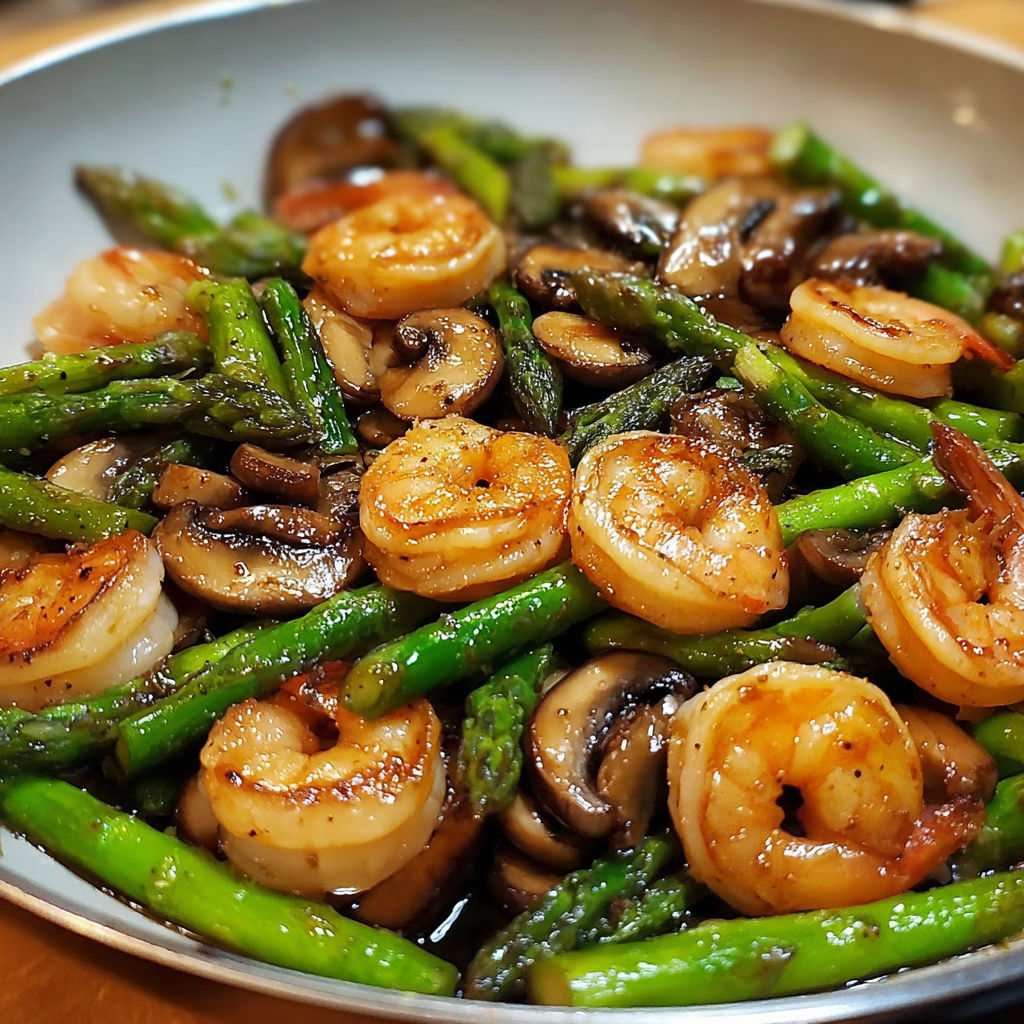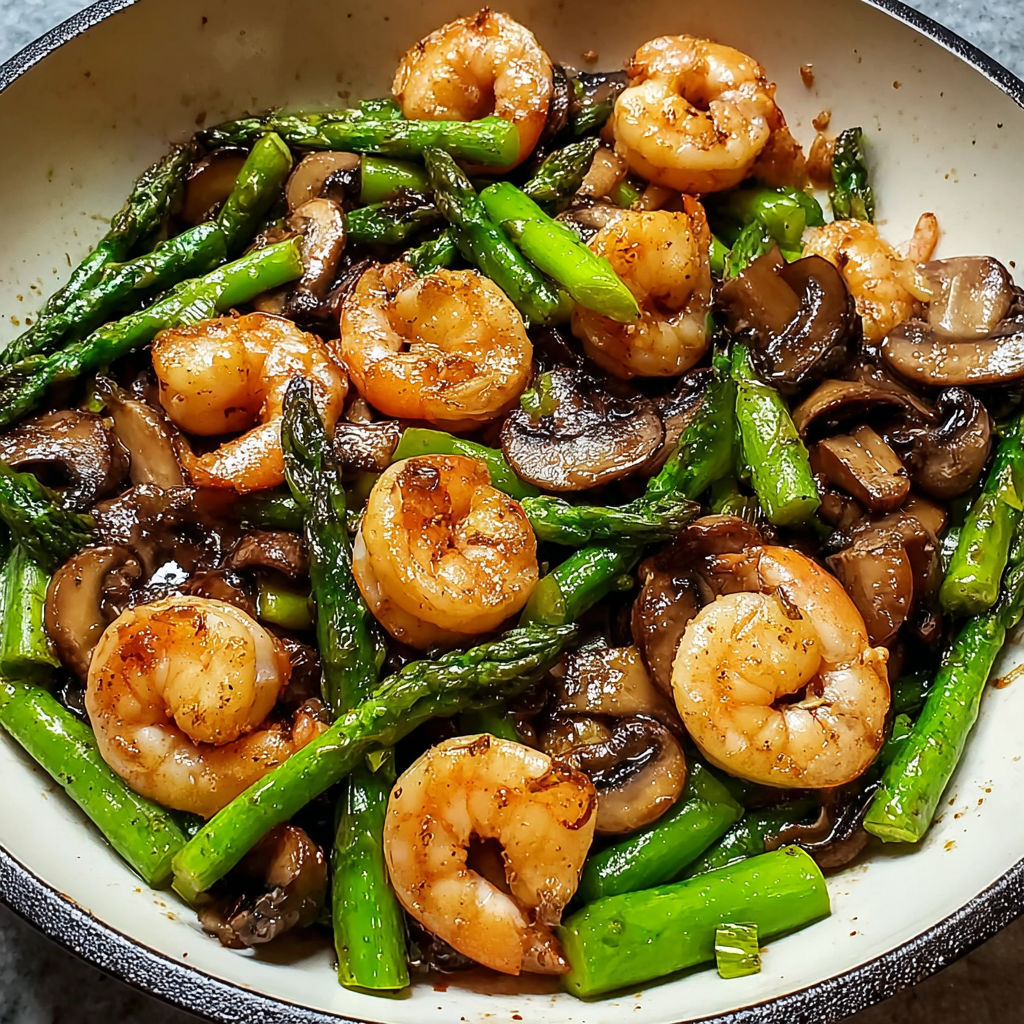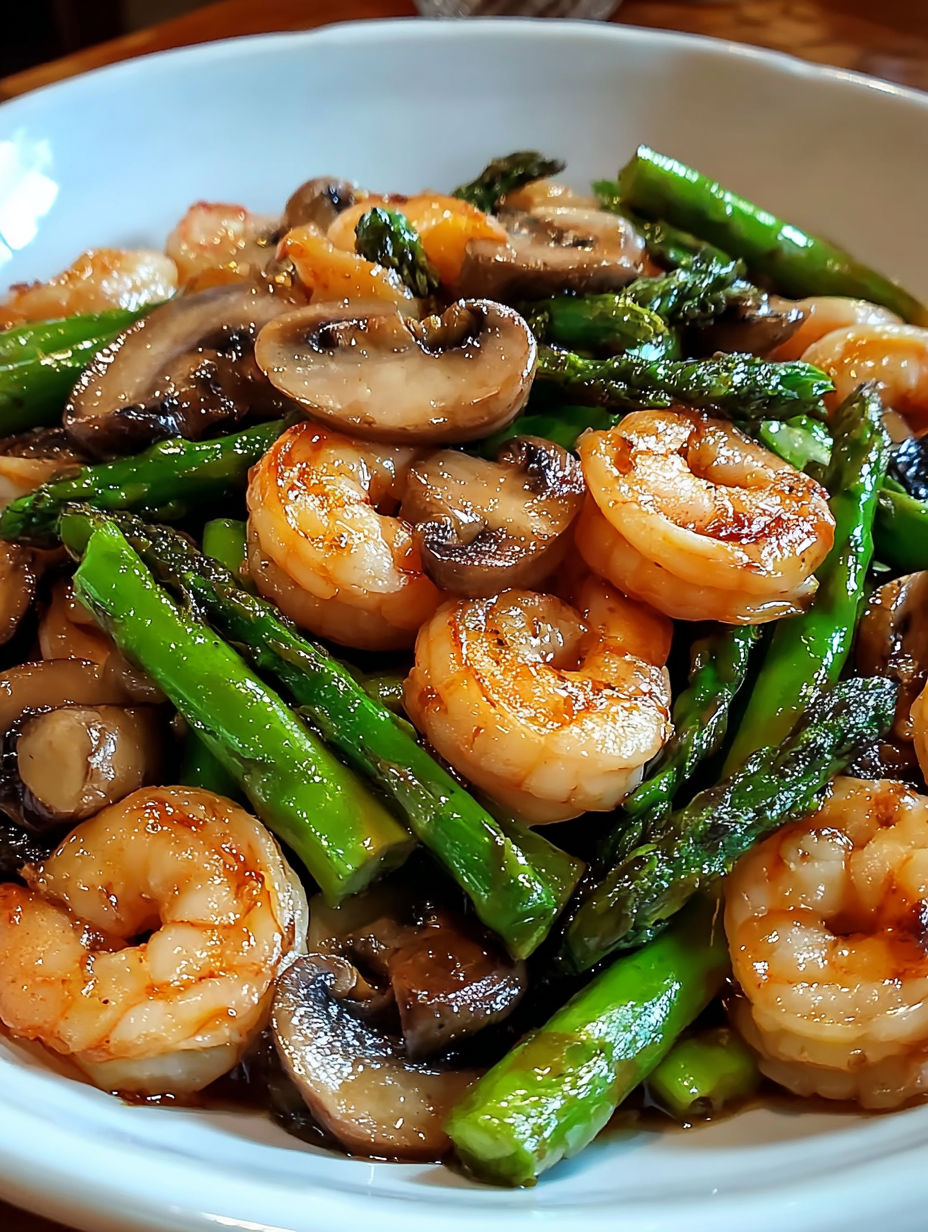 Pin
Pin
This vibrant shrimp and asparagus stir fry has been my go-to weeknight dinner for years, combining protein-rich seafood with crisp vegetables in a savory Asian-inspired sauce that comes together faster than takeout delivery.
I first created this recipe during a busy exam week in college when I needed quick nourishment. Now it's become a regular in my dinner rotation, especially during asparagus season when those tender spears are at their peak.
- Shrimp fresh or frozen both work beautifully, but look for wild-caught when possible for the best flavor and sustainability
- Asparagus choose bright green stalks with tight, compact tips for the freshest flavor and snap
- Mushrooms cremini or shiitake add wonderful umami depth, but any variety works well
- Soy sauce provides the salty foundation for the sauce, opt for low-sodium if watching salt intake
- Oyster sauce adds a distinctive rich umami quality that brings restaurant authenticity to your homemade version
- Sesame oil a finishing touch that adds nutty aroma, a little goes a long way
- Garlic fresh minced cloves create the aromatic base of the dish
- Ginger fresh grated root adds a warm spiciness that complements the seafood perfectly
- Vegetable oil use a neutral oil with a high smoke point for proper stir frying
- Salt and pepper minimal amounts needed as soy sauce provides most of the seasoning
- Rice or noodles provides the perfect base to soak up all that delicious sauce
How To Make Shrimp and Asparagus Stir Fry
- Prepare ingredients
- Mise en place is crucial for stir frying. Have everything chopped, sliced, and ready before heating your pan. Trim the woody ends from asparagus and slice on a diagonal for maximum sauce absorption. Make sure shrimp are completely thawed if using frozen.
- Create a quick marinade
- Tossing the shrimp with just a tablespoon of soy sauce while you prepare other ingredients gives them a head start on flavor development. This brief marinade helps the shrimp maintain moisture during the high-heat cooking process.
- Heat the wok properly
- Allow your wok or large skillet to get properly hot before adding oil. The oil should shimmer but not smoke. This crucial step prevents sticking and ensures that perfect stir fry sear on all ingredients.
- Master the cooking sequence
- Add ingredients in order of cooking time. Begin with aromatics, then shrimp which cook quickly, followed by vegetables. The asparagus should maintain some crispness when finished. Stir constantly to prevent burning.
- Sauce integration
- Add sauces toward the end of cooking when vegetables are nearly done. This prevents them from reducing too much and becoming overly salty. The brief cooking time allows the flavors to meld while maintaining the sauce's consistency.
- Final flavor boost
- Drizzling sesame oil at the very end rather than cooking with it preserves its delicate flavor that would otherwise be lost to high heat. This final touch elevates the entire dish with its distinctive nutty aroma.
The ginger in this recipe is my secret weapon. I keep a knob in the freezer and grate it while frozen directly into the pan. The aroma that hits when it meets the hot oil takes me back to my grandmother's kitchen where I first learned to appreciate these flavors.
Perfect Pairings
This stir fry stands beautifully on its own, but for a complete meal, consider serving it alongside steamed jasmine rice or rice noodles. For special occasions, I add crispy spring rolls as a starter and finish with mango sticky rice for dessert. The contrast between the savory stir fry and sweet fruit creates a memorable dining experience.
Simple Substitutions
Don't let missing ingredients stop you from enjoying this dish. Chicken or tofu can replace shrimp for equally delicious results. Broccoli, green beans, or snow peas work wonderfully in place of asparagus. No oyster sauce? A splash of fish sauce or even Worcestershire sauce with a pinch of sugar creates a similar depth. The recipe remains delicious with whatever you have on hand.
Make-Ahead Tips
While stir fries are best enjoyed immediately, you can prepare all the components ahead of time. Clean and chop vegetables, peel and devein shrimp, and mix the sauce ingredients up to 24 hours in advance. Store everything separately in the refrigerator. When ready to cook, the actual stir frying takes just minutes, making this perfect for busy weeknights or last-minute entertaining.

Storage Secrets
Though best enjoyed fresh, leftovers can be stored in an airtight container in the refrigerator for up to two days. Reheat gently in a skillet with a splash of water to rejuvenate the sauce. I find the flavors often deepen overnight, making day-two stir fry particularly delicious. However, avoid freezing as the texture of both shrimp and asparagus will suffer significantly.

Recipe FAQs
- → What can I substitute for oyster sauce?
If you don't have oyster sauce, you can substitute with hoisin sauce, fish sauce, or a mix of soy sauce with a bit of sugar to replicate the sweet-savory balance. For a vegetarian option, consider using mushroom-based stir-fry sauce or an extra tablespoon of soy sauce with a pinch of sugar.
- → How do I know when the shrimp are perfectly cooked?
Perfectly cooked shrimp turn from translucent gray to opaque pink with a slight curve (forming a 'C' shape). They should feel firm but still tender when pressed. Overcooked shrimp curl tightly into an 'O' shape and become rubbery. In a hot stir-fry, this typically takes just 2-3 minutes total.
- → Can I use frozen asparagus instead of fresh?
While fresh asparagus provides the best texture and flavor for stir-fries, frozen asparagus can work in a pinch. Thaw completely and pat dry before cooking to prevent excess moisture. You may need to reduce cooking time slightly as frozen asparagus is partially cooked during processing.
- → What other vegetables work well in this stir-fry?
This stir-fry is versatile and works well with many vegetables. Try adding bell peppers, snow peas, broccoli florets, sliced carrots, or baby bok choy. Just adjust cooking times accordingly—add harder vegetables earlier and more delicate ones later in the cooking process.
- → How can I make this dish spicy?
To add heat, incorporate sliced fresh chilis or red pepper flakes when sautéing the garlic and ginger. Alternatively, add a teaspoon of chili garlic sauce, sriracha, or sambal oelek to the sauce mixture. For a milder approach, serve with chili oil on the side so each person can adjust the spice level.
- → Can I prepare any components ahead of time?
Yes! To save time, clean and devein shrimp, chop vegetables, and mix the sauce ingredients up to 24 hours in advance. Store each component separately in the refrigerator. The actual stir-frying should be done just before serving for the best texture and flavor.
